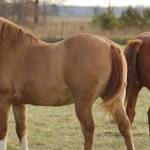Grazing Muzzles for Horses: How Effective Are They?

When they were introduced in the 1990s, grazing muzzles were hailed by owners of chubby horses as the best thing to come along in quite a while. Consisting of a webbing basket that fits over the lower half of the horse’s face, the grazing muzzle allows a horse or pony to bite off and swallow only the few grass blades that stick up through a small hole in the plastic plate at the bottom of the device. Horses wearing the grazing muzzle can be turned out into the pasture with their buddies, exercise when they want to, avoid stall boredom, drink water freely, eat more or less constantly, and still ingest a limited amount of forage. By reducing their intake of lush grass, many horses have shed excess body weight and lowered their risk for colic and laminitis.
Four mature ponies were used in a study conducted in the U.K. to determine the amount by which forage intake was reduced when grazing muzzles were used. In each of four three-hour study periods, two ponies wore grazing muzzles and two ponies grazed without muzzles. The ponies wore harnesses to collect urine and feces passed during the grazing periods, and were weighed before and after each period. All ponies had been accustomed to the grazing muzzles, collection harnesses, and protocols at the beginning of the study. When they were not grazing, the ponies were stalled and given hay, a vitamin/mineral mix, and free access to water. They were lightly exercised for 30 minutes on two or three days each week.
Results showed a wide variation in the amount of pasture grass consumed in each study period among both muzzled and unmuzzled ponies. For ponies wearing muzzles, pasture dry matter intake during each period was reduced an average of 83% compared to when the ponies were not wearing muzzles.
Unmuzzled ponies in this study also showed behavior similar to what has been reported by owners of other overweight horses. When these ponies were turned out for only three hours a day without muzzles, they made good use of their grazing time, eating with serious intent and taking few breaks to nap, play with their pasture buddies, or engage in other behaviors seen in idle horses at pasture. The ponies were so focused on eating that they managed to ingest between half and two-thirds of their daily dry matter requirement in only three hours. Thus, moderate reductions in pasture time for overweight equines may not produce the weight-loss effects owners are expecting. Muzzling allows the horses to spend more time in the pasture while effectively limiting forage intake.
While the grazing muzzle works well for many horses in limiting intake of carbohydrate-rich grass, other equines have shown amazing persistence and ingenuity in their ability to pull, push, or scrape the muzzle out of position so they can continue to eat without restriction. Some manufacturers have redesigned their products so that this is less of a problem than when the muzzles were first introduced.








